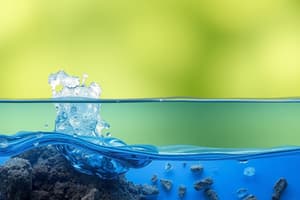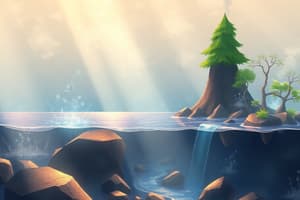Podcast
Questions and Answers
What is the primary source of energy required for evaporation?
What is the primary source of energy required for evaporation?
- Temperature
- Humidity
- Wind
- Sun (correct)
What is the term used to describe the combination of transpiration and surface evaporation?
What is the term used to describe the combination of transpiration and surface evaporation?
- Transpiration
- Evapotranspiration (correct)
- Humidity evaporation
- Surface evaporation
What percentage of evaporation occurs from the oceans?
What percentage of evaporation occurs from the oceans?
- 95% (correct)
- 75%
- 50%
- 100%
What is the role of evaporation in the water cycle?
What is the role of evaporation in the water cycle?
What is the effect of increased wind speed on evaporation?
What is the effect of increased wind speed on evaporation?
What is the term used to describe evaporation that occurs from plants and soil?
What is the term used to describe evaporation that occurs from plants and soil?
What is the term used to describe the transformation of water from its liquid form to water vapor?
What is the term used to describe the transformation of water from its liquid form to water vapor?
What factor increases the rate of evaporation?
What factor increases the rate of evaporation?
What type of evaporation occurs from the surface of oceans, lakes, and rivers?
What type of evaporation occurs from the surface of oceans, lakes, and rivers?
What is the result of evaporation on the Earth's climate and weather patterns?
What is the result of evaporation on the Earth's climate and weather patterns?
What is the relationship between surface area and evaporation rate?
What is the relationship between surface area and evaporation rate?
What is the role of evaporation in the water cycle?
What is the role of evaporation in the water cycle?
Flashcards are hidden until you start studying
Study Notes
Evaporation
Definition: Evaporation is the process by which liquid water is transformed into water vapor.
Key Factors:
- Temperature: Higher temperatures increase the rate of evaporation.
- Humidity: Lower humidity allows for faster evaporation.
- Wind: Increased wind speed enhances evaporation.
- Surface area: Larger surface areas of water lead to greater evaporation.
Types of Evaporation:
- Surface evaporation: Occurs from the surface of oceans, lakes, and rivers.
- Transpiration: Evaporation from plants and soil.
- Evapotranspiration: Combination of transpiration and surface evaporation.
Importance:
- Water cycle: Evaporation is the first step in the water cycle, driving the movement of water throughout the Earth's systems.
- Weather patterns: Evaporation influences the formation of clouds and precipitation.
- Ecosystems: Evaporation plays a crucial role in regulating the water balance in ecosystems.
Interesting Facts:
- 95% of evaporation: Occurs from the oceans, with the remaining 5% from land surfaces.
- Energy requirement: Evaporation requires energy from the sun, which is approximately 540 calories per gram of water.
Studying That Suits You
Use AI to generate personalized quizzes and flashcards to suit your learning preferences.



